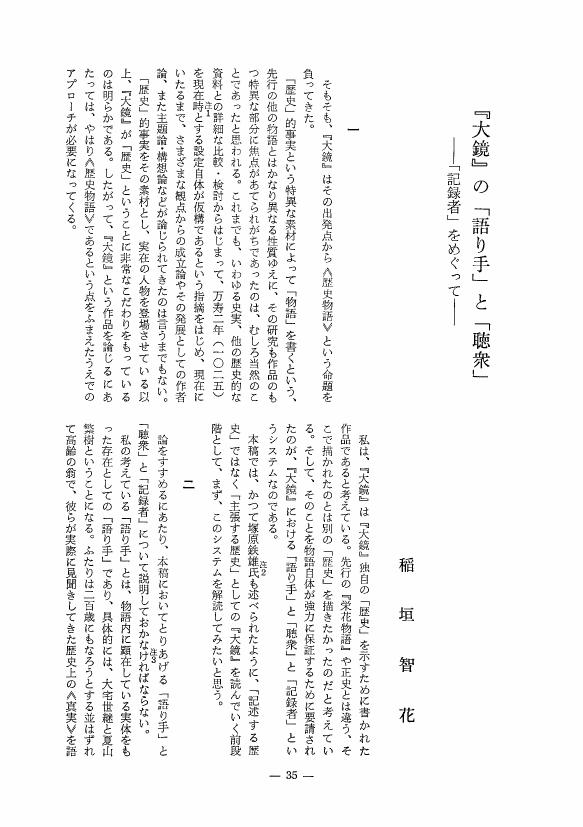18 0 0 0 OA 近代日中における接尾辞「的」の受容
- 著者
- 稲垣 智恵
- 出版者
- 関西大学文化交渉学教育研究拠点(ICIS)
- 雑誌
- 東アジア文化交渉研究 = Journal of East Asian Cultural Interaction Studies (ISSN:18827748)
- 巻号頁・発行日
- vol.3, pp.279-299, 2010-03-31
Many Japanese suffixes, such as 的 “-teki” were created in the early Meiji period in order to translate Western languages with inflection, and they were also introduced to China. To date, those suffixes have been used in both Chinese and Japanese as they can be found in modern Chinese and Japanese lexicons. While the Japanese suffix, 的 “–teki” is used to add an adjective meaning to a noun, whereas the Chinese 的 “de” is not . By comparing the usage of the suffix 的,this paper examines how differently Western languages with inflection were understood by Chinese and Japanese people, as well as, how the usage and meaning of the suffix have changed over time.
17 0 0 0 OA 近代日中における接尾辞「的」の受容
- 著者
- 稲垣 智恵
- 出版者
- 関西大学
- 雑誌
- 東アジア文化交渉研究 (ISSN:18827748)
- 巻号頁・発行日
- vol.3, pp.279-299, 2010-03-31
Many Japanese suffixes, such as 的 "-teki" were created in the early Meiji period in order to translate Western languages with inflection, and they were also introduced to China. To date, those suffixes have been used in both Chinese and Japanese as they can be found in modern Chinese and Japanese lexicons. While the Japanese suffix, 的 "–teki" is used to add an adjective meaning to a noun, whereas the Chinese 的 "de" is not . By comparing the usage of the suffix 的,this paper examines how differently Western languages with inflection were understood by Chinese and Japanese people, as well as, how the usage and meaning of the suffix have changed over time.
12 0 0 0 OA 近代日中における接尾辞「的」の受容
- 著者
- 稲垣 智恵
- 出版者
- 関西大学文化交渉学教育研究拠点(ICIS)
- 雑誌
- 東アジア文化交渉研究 = Journal of East Asian Cultural Interaction Studies (ISSN:18827748)
- 巻号頁・発行日
- vol.3, pp.279-299, 2010-03-31
Many Japanese suffixes, such as 的 “-teki” were created in the early Meiji period in order to translate Western languages with inflection, and they were also introduced to China. To date, those suffixes have been used in both Chinese and Japanese as they can be found in modern Chinese and Japanese lexicons. While the Japanese suffix, 的 “–teki” is used to add an adjective meaning to a noun, whereas the Chinese 的 “de” is not . By comparing the usage of the suffix 的,this paper examines how differently Western languages with inflection were understood by Chinese and Japanese people, as well as, how the usage and meaning of the suffix have changed over time.
2 0 0 0 OA 文化財建造物における防火対策の進展 ノートルダム大聖堂火災、首里城跡火災を踏まえて
- 著者
- 稲垣 智也
- 出版者
- 建築史学会
- 雑誌
- 建築史学 (ISSN:02892839)
- 巻号頁・発行日
- vol.75, pp.97-111, 2020 (Released:2021-10-21)
2 0 0 0 OA 『大鏡』の「語り手」と「聴衆」 ―「記録者」をめぐって―
- 著者
- 稲垣 智花
- 出版者
- 中古文学会
- 雑誌
- 中古文学 (ISSN:02874636)
- 巻号頁・発行日
- vol.45, pp.35-43, 1990-06-20 (Released:2019-03-10)
2 0 0 0 OA 粒子ベース流体シミュレーションを用いた炎のリアルタイムレンダリング
- 著者
- 稲垣 智 井村 誠孝 池田 聖 眞鍋 佳嗣 千原 國宏
- 雑誌
- 研究報告グラフィクスとCAD(CG)
- 巻号頁・発行日
- vol.2010-CG-138, no.14, pp.1-6, 2010-02-04
映画やゲームにおいては,炎を写実的かつリアルタイムにレンダリングする手法が求められている.炎の CG はエンタテインメントのみならず,防災のための火災シミュレータなどにおいても有用である.本論文では,炎を粒子ベース流体シミュレーションに基づき,写実的かつリアルタイムにレンダリングする手法を提案する.炎を写実的にレンダリングするには,三つの条件を満たすことが重要である.一つ目の条件は,炎が風のような力の影響を受けて変形することである.二つ目の条件は炎の明るさと色が正確であることである.三つ目の条件は,炎の周辺に陽炎が発生することである.提案手法はこれら三つの条件を満たすように粒子ベース流体シミュレーションすることで,炎を写実的かつリアルタイムにレンダリングする.提案手法を実験し,写実的かつリアルタイムにレンダリングできることを確認した.
- 著者
- 稲垣 智則
- 出版者
- 東海大学課程資格教育センター
- 雑誌
- 東海大学課程資格教育センター論集 (ISSN:13492438)
- 巻号頁・発行日
- no.12, pp.13-25, 2013



